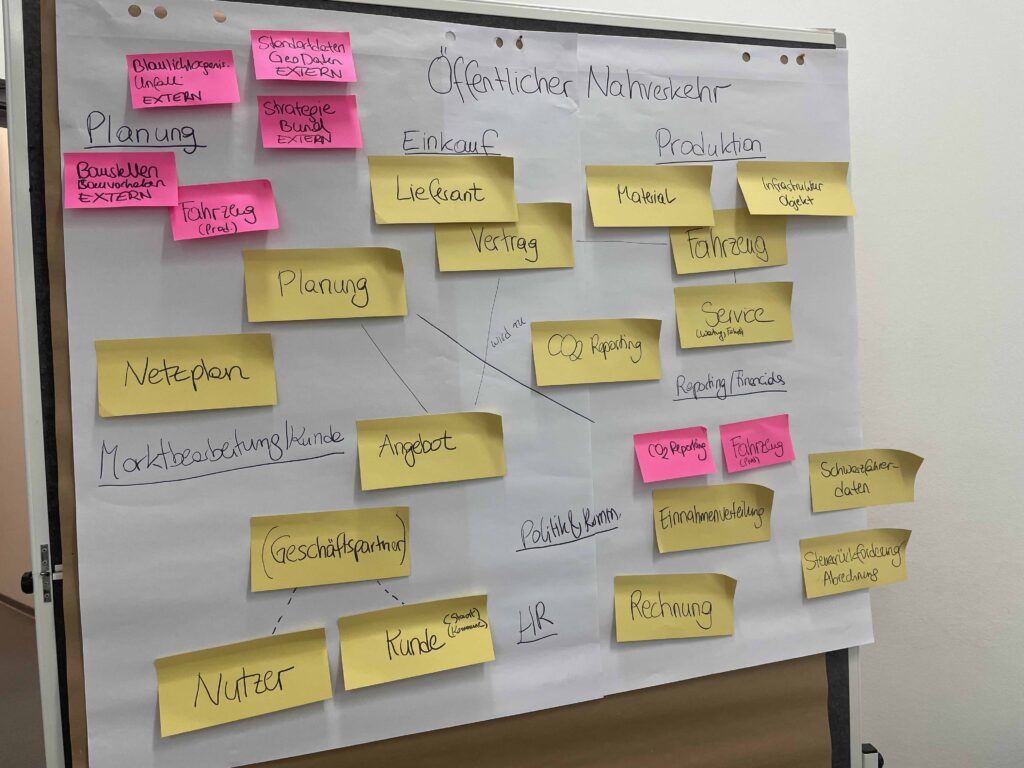The workshop "How to make a data map" at the TDWI trade fair 2022 in Munich was a great success. In this glean we tell you what a data map is, why every company needs one and how to get clear results within a short timeframe.
The first question that arises is: What is a data map anyway? A data map provides all stakeholders in the company with an easy-to-understand 4-dimensional overview ofthe most important company data. From a high-level perspective, it illustrates which data domains and data exist in the enterprise, where it resides (system) and originates (golden source), and which role, as a first step in data governance, is responsible for it. In this way, the data intersections across the business functions of a company are shown and their relationship to each other becomes clear.
The participants of the workshop at TDWI agree: they often don't know what data exists in their business, how it is interrelated, where the most important data is located in the first place, and who is available to answer questions about it. In short, a broad, understandable overview of the most important data in the company is often missing. So the benefit of the data map quickly becomes clear: the data map fulfills versatile data needs for different stakeholders in an organization.
For top management, for example, it provides an overview of the data landscape that is required for controlling, further developing and digitalizing the business. The data map also provides a starting point for implementing innovations and finding contacts for important data throughout the company. Operational and IT managers see and understand the data connections to other departments, recognize the intersections of data and thus the interrelationships of the business. They now know: who owns - and who doesn't own - what data. Data stewards and data governance leads also see at a glance where in the company which important data resides and establish a cross-business unit language and awareness for data, which forms the basis for any collaboration.
The presenters Barbara Kainz, Katharina Menz and Wanja Eiche consequently conclude: On the one hand, a data map is the framework and starting point for the step-by-step roll-out of the data strategy, data initiatives and data governance. On the other hand, it provides the high-level understanding of the business and the basic data as a prerequisite for every use case in which data is needed. For these reasons, every company with a data-related use case benefits from a data map.
The participants of the TDWI workshop were as diverse as the reasons for creating a data map. Due to the large number of participants and the variety of industries represented, the participants were divided into three showcase groups and encouraged to bring in use cases from their own companies. With success: three extensive data maps from the three industries, public transport, banking and camping equipment manifested themselves on the flipcharts within a very short time (see photos).
The procedure is similar for a "real" use case in customer projects. For workshop planning, it is advisable to consult the organization chart or, if available, an organization manual in order to identify core and support functions as data domains, as well as relevant persons for workshop participation. Depending on the size and complexity of the organization, workshops vary in group size, duration and number. Usually, there is an initial 2.5h-3h workshop with relevant representatives of the different business functions. Additional 1.5-2h workshops at the business function level are used for detailing and quality assurance. A data map is therefore by no means a long or complex project, but rather dokuments the knowledge of the employees in a targeted and structured manner - the result is as informative and comprehensible as in the TDWI showcases.
Just as at the TDWI, no preparation is required on the part of the participants in the real customer project. dataspot. Consultants meet people on their home-turf: in their daily work and their business capabilities. And practice has confirmed: the results tumble onto the flip charts even without data expertise.
All in all, it becomes clear that no matter what industry you are in, there must be an overarching awareness of the business and its data. Experience has also shown: the data map is an outstanding starting point for a business data model, which in turn can serve as the basis for a DWH implementation. A small step for the business department, a big step for every company.


